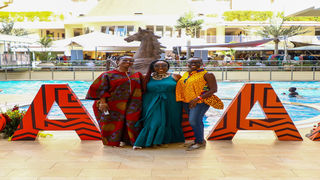
Victoria Ijeoma, CEO Vikkie Oh Atelier, Fashion stylist, Connie Aluoch and Sandra Simbiri during the Sanaa Kenyan fashion show, a platform for designers and exhibitors held at Movenpick Hotel Nairobi on August 26, 2023. The event aims at supporting and celebrating the made-in-Kenya creative fashion industry. PHOTO WILFRED NYANGARESI
|Saturday Magazine
Premium
The new Kenyan designers defining our fashion trends
What you need to know:
‘What is our style as Kenyans?’ A number of emerging designers are asking this question and offering a solution
Kenyan designers are rising up to the occasion to meet Kenyans’ fashion demands and needs that are ever-growing. As fast fashion continues to flood online thrift stores, some designers are making a difference in the Kenyan fashion scene.
Designer Wanjiru Namunyak, Dhana_Vito Jewelry collection
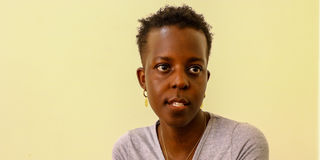
Designer Wanjiru Namunyak of Dhana_Vito Jewelry during the Sanaa Kenyan fashion show, a platform for designers and exhibitors that aims at supporting and celebrating the made-in-Kenya creative fashion industry. PHOTO| WILFRED NYANGARES
Just like most young girls, Wanjiru Namunyak looked forward to growing up and finally being able to wear jewellery with her outfits as she left the house - a common thing that women do.
She soon came to find out that this would not be possible because of eczema, a condition that makes her skin itchy and dry especially whenever she wore certain types of jewellery and even clothing.
“My skin would flare up and it was hard to wear jewellery made from nickel, sweaters and tight clothes,” she says.
Despite this, Wanjiru found a way to satisfy her love for jewellery by making her own pieces at home by experimenting with beads and copper. After completing her studies in Product Design at the University of Nairobi, she decided to turn it into a full-time affair when she started making brass jewellery and founded her online store, Dhana Vito. The name is derived from a Swahili phrase - vitu za dhamani which means things of great value.
“Every collection I have made is inspired by plant life and animals which I call flora and fauna. The dandelion collection was inspired by a stroll I took with my mum during the 2020 lockdown period where I saw dandelions on the ground. I drew inspiration from banana trees…. even flying termites have been part of my designs!”
Wanjiru, however, found that she had not yet solved her problem and later, when she started selling her jewellery, that she wasn’t suffering alone.
“There are some people whose skin gets irritated by brass, copper and other materials. I have met someone who could not wear any metal even pure gold,” she says.
Brass tarnishes over time through oxidisation with two of its main components - copper and zinc. The jewellery then begins to turn greenish ruining its original appearance. Even though it is one of the cheapest materials, it has a yellow colour that closely resembles gold and has more often been used to make African pieces.
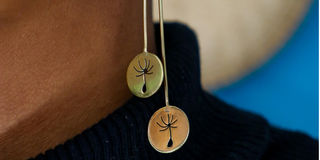
Earring samples from Dhana_Vito Jewelry collection PHOTO| WILFRED NYANGARESI
“Unfortunately, I still could not wear my own pieces since brass also irritated my skin. I also got a lot of feedback from clients whose pieces tarnished especially when they travelled to the coast. I took a risk and decided to make them hypoallergenic by coasting them with three-micron heavy gold. It is a very thin plating that lies flat on the brass that protects it from tarnishing,” Wanjiru says.
She works with an artisan who now makes her designs which are not engraved but cut through the metal which requires delicate handiwork since the lining is very thin and precise to correctly mimic her artwork, especially her dandelion collection.
“The brass material is locally sourced while the gold plating is from the USA. This one of the reasons why my prices went up,” she says.
With the plating, Wanjiru can now wear her own jewellery without worrying about her skin or the jewellery losing its colour. This new addition, however, made her jewellery more expensive. Now her pieces range between Sh3,000 to Sh20,000.
“More people today make more meaningful purchases that last longer than buying cheap quality ones. I think slow fashion is the way to go to support small businesses. A lot of my clients are repeat customers who also influence their friends to buy from me. Sales fluctuate during the year but we make more during the holiday seasons, especially in December. However, the shift was difficult because I had to explain why my pieces cost more than usual,” she explains.
Designer Hellen Tolbert, Ellen designs
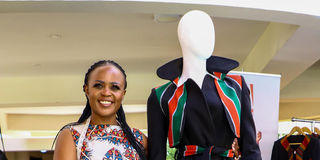
Kenyan fashion designer Hellen Tolbert is one who understands Wanjiru’s plight all too well. With 10 years’ experience in the fashion industry, she believes that Kenyan fashion is evolving as more fashion designers are putting more effort into making high-quality fashionable clothing hence the high prices. Like any other business, she says that the cost of production is highly affected by increased shipping costs and electricity prices.
“I challenge you to go to a Zara and pick a trenchcoat and compare it to my trench coats. I am that confident about our finishes and quality,” she says.
The 39-year-old is now the owner and lead designer of Ellen Designs where she is more focused on dressing the ‘contemporary woman’ with a hint of Africanism.
“When we talk about African fashion, we do not just mean kitenge. Africa has so much more to offer, especially Kenya. We have Kenyan-made fabrics that people are yet to explore but people usually just run for the kitenge. If we find a unique way to use what we have within our borders, I think we will skyrocket,” she says.
On display at her stall is a trenchcoat with subtle additions of kikoy on the wrist and back for some extra flare. The piece goes for Sh26,000. Another jacket hanging on a coat rack with Ankara flaps made from Maasai shuka fabric is priced at Sh13,500.
“After I quit my job to start my business, the first design I made was a jacket. So jackets remind me of where it all started. I continued to perfect my designs until I became famous because of them,” she says.
The designer based in Buruburu says that she did not limit herself to jackets and works with different types of fabrics and designs such as dresses. She recently designed Maryanne Mudavadi, Musalia Mudavadi’s daughter’s emerald green dress for her traditional wedding ceremony held earlier this month.
“It was one of the highlights of my career. Working with her was a treasured moment and a pleasure since she was very understanding and easy to work with. She knew what she wanted - something simple and classy - and we were able to execute it,” Hellen says.
Like most small fashion businesses, Hellen relies on social media such as Instagram, Facebook and TikTok to reach her potential clients. She grew up in Maringo, surrounded by fashion. Her mum was a tailor at Bama Market and even after retiring, she continues tailoring.
“What has always helped me survive was starting small. I started my business with Sh5,000. As long as I have that amount in my pocket, I know I can survive even when tough times hit like Covid-19,” she says.
She asks Kenyans to challenge fashion designers more by holding them responsible for their mistakes and giving them a chance to make their designs and quality better.
Designer Kuiyu Kang’ari, Liquid Lemn designs
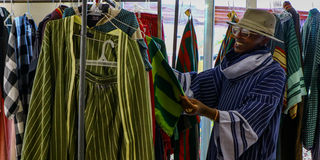
Kuiyu Kang'ari, a designer popularly known as Liquid Lemn admires some of his Mistari collection outfits during the Sanaa Kenyan fashion show PHOTO| WILFRED NYANGARESI
29-year-old Kuiyu Kang’ari is another fashion designer who makes a statement using his designs that challenge the status quo to incorporate gender-fluid and non-binary people.
“Liquid Lemn was born in 2021 out of the frustration of finding Kenyan-made unisex pieces in the market. I sought to create a brand that would include gender-fluid people, their bodies, styles and identities. For me, it is not just selling the garments but also letting people become who they truly are,” he says.
The Mistari collection, made using kikoy material, consists of free-flowing clothing designs such as kimonos and snoodies with pockets in a variety of unique and playful patterns. The snoodie costs Sh7,500 while the kimonos start from Sh6,500, depending on size. Kuiyu says that as much as Ankara material is considered African, kikoy material originated from the East African coast.
“The idea came from feeling comfort whenever I wore a kikoy or wrapped it around myself. It was not a feeling I was used to since I was always wearing denim and khaki materials,” he says.
His designs have been worn by Yo-Yo Ma, a Grammy Award-winning French-American cellist and one of the world’s most celebrated classical musicians, who performed in Nairobi in June this year.
Kuiyu says the simplicity and functionality of the outfits are intended to create modern attire that is meant to discourage body dysmorphia and cater to a range of sizes so that everyone can find a perfect fit.
Designer Nusra Nural Ain, co-founder of Nuralains designs
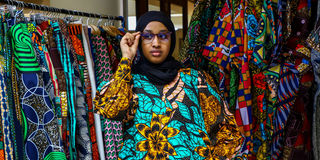
Nasra Nuralain, CoFounder the_nuralaubs during the Sanaa Kenyan fashion show PHOTO| WILFRED NYANGARESI
Nusra Nural Ain shares a similar dream of making more size-inclusive African wear. She is the co-founder of Nuralains where she makes clothing for the modern but modest woman.
“I realised Kenyans love colourful prints but do not have the clothes ready-made. Before I started the ready-to-wear collection, it was more like a custom fashion brand,” she said.
For the plus size designs, Nusra started making clothes to fit sizes 16 and 18 but clients complained they still did not accommodate them. She then added sizes 20 and 22.
“I want my clients to feel regal and powerful, regardless of size. I charge the same price for all the sizes. Most of the designs are usually free size so I do not feel the need to increase the price for the same design and print,” she says.
Also read: High on tea: The heavy cost of experience
She adds that most of her clients come from the diaspora. Her collections come in sets such as the Salsa set, comprising a pair of palazzo pants, a loose crop top and a kimono, which costs Sh6,500. For the modest woman, she recommends the shirt combo that comes with a shirt dress and a kimono all for Sh6,000. Some pieces such as the kimono are sold separately at Sh2,500.
“If worn and styled separately, you can get several outfits from the sets. The Salsa set is my first ready-to-wear collection,” she said.
Isabell Wambui on the other hand, got back into the fashion business to wave the Kenyan flag internationally through pure leather bags made in Kenya. She quit her finance job in a UK fashion house and started her own brand, Anchor Leather. She gives credit to her experience of knowing how a fashion business operates which helped her start and run her business.
"All of our bags have a small Kenyan flag stitched on. We sell them all over the world. The goodness of leather is that it never goes out of style. The older it gets, the more beautiful it becomes. It can be passed down from one generation to another," said Isabell.
Her store sells a variation of bags from Sh5,000 to Sh42,000. She says that most designs have a unique African touch like a strip of animal skin hide, Ankara print or beadwork.
“We have a niche market that wants quality products. We have twenty employees who are guaranteed permanent employment from January to December. When the demand gets high during holiday seasons, we hire casual workers,” she said.
Apart from creating quality bags from scratch, she says that the business made it easier for artisans to be employed, especially women.





